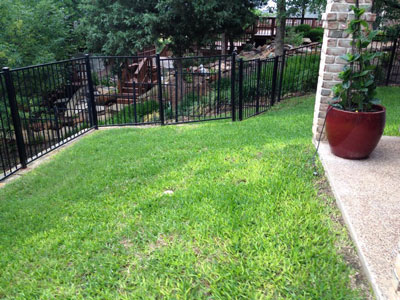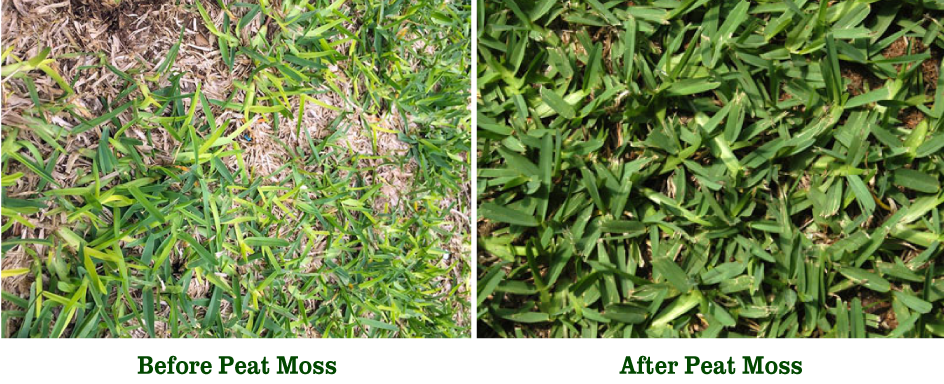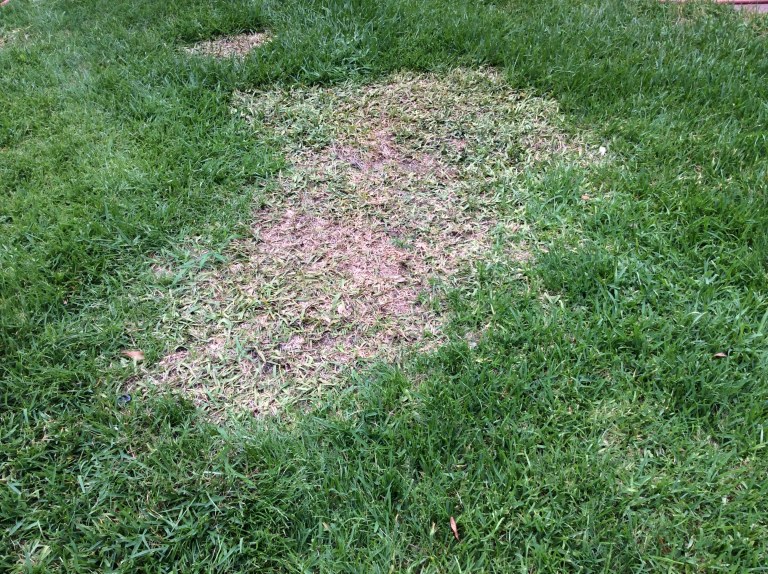

Brown patch/Large patch fungus and Take-all Root Rot (TARR) are two unwelcome Fall and Winter visitors to our South Texas lawns. Cool nighttime temperatures and moisture on the grass from rain, dew, or excessive watering frequency are the two main factors promoting these diseases. Large patch is relatively easy to diagnose visually if you are familiar with the symptoms. TARR has more subtle and varying symptoms and requires 60x or greater magnification to positively ID. Large patch is an unsightly annoyance for Fall and Winter, but damaged grass will regrow in Spring. TARR does not show much damage while the disease is spreading over Winter, but when hot temperatures arrive in Summer, the weakened roots and runners are unable to support the water requirements of the infected areas, and they decline or die.
There is no “curing” or eliminating these diseases, but you can attempt to prevent them, or manage them, by various means. Culturally, you should “goldilocks” your lawn: not too much water, not too little, but just right. Water deeply when needed to avoid drought stress but keep the frequency of application to a minimum. Mow as often as needed. Do not let grass grow too tall, but do not cut it too short. Fertilize according to recommended timing and quantity, not too much or too little. If you see a fungus damaged area, mow it last to minimize spreading into healthy areas. Keep mower blades sharp, so grass is cleanly sliced rather than ripped with slower-healing ragged edges. Any stresses make the lawn more vulnerable to infection by a harmful fungus.

We have fungicides that can help prevent or suppress harmful fungus, but keep in mind that there are also beneficial fungal organisms that recycle dead organic matter into plant nutrients and help prevent thatch. So excessive fungicide use, like most excesses, can cause new problems. My personal recommendation is to let large patch fungus run its course, as it does no permanent damage, just temporary unsightliness. But I recommend topdressing TARR infected lawns with peat moss, to control (can’t eliminate) the disease, as the damage is permanent. Best is for you to bring in some samples (still alive but with symptoms) and photos for us to look at, and offer to you various courses of action, for you to choose whatever approach you are most comfortable with.

-James



Cheri says
This response is for Lorrie and James. I live in the Bluff too and I get the best results by watering 2 days in a row every week. 30 minutes for the first day and 40 minutes on the second. I have a beautiful yard. However, I’d like to plant native grasses that don’t have that high need for water. Any ideas, James?
James Gill says
I had no luck with buffalo grass on sand. Little bluestem is very well adapted and native to the
Bluff, and is very attractive, but is not low like a “lawn” and should only be mowed once a year. I also like bushy bluestem, and maybe you would consider paspalum and some other natives I am not as familiar with because they are not as showy as the 2 New World bluestems. Do not use Old World bluestems such as King Ranch or Kleberg, they are undesirable non-natives. I think we will all need to be landscaping in that fashion in another 10 or 20 years and lawns will be pretty much extinct, other than a very small area you can water with recycled gray water.
https://aggie-horticulture.tamu.edu/newsletters/hortupdate/hortupdate_archives/2005/sept05/LittleBS.html
susan says
In regards to the fungus- do u suggest getting rid of the affected areas ?
James Gill says
If the area is dead, you will need to replace, and treat. If still alive, just treat.
Lorrie Pierce says
A gentleman at Gills diagnosed my grass as having Take All Patch Root Rot and I applied the recommended peat moss three times over the last year, but have seen little or no improvement. I understand it may take longer before positive results occur. Here is my question though. I live in Flour Bluff and the previous owners installed what I assume is Saint Augustine grass over a layer of dirt, but directly under the dirt is sand. When I water, the water just flows right through the sand. Additionally, during warm weather, when I water only once a week, the rest of the lawn becomes so dry it’s crunchy to walk on, so it seems unlikely that over watering or too much moisture could be the problem. Any thoughts please?
James Gill says
Thoughts, yes. But omniscience, no. Take All is a new problem, without well established, proven effective protocols for all circumstances. I was surprised last year to find Take All in Billish Park on the island, 100% sand. Excessive watering does seem to encourage it, but I have also found it in plenty of lawns with no irrigation system. Hence my “Goldilocks” reference, just do your best to be even in all practices, water enough not too much, same with fertilizer and mowing, and hope for the best. We do not have a perfect solution, or a turf variety that is resistant to Take All. I do know that we have brought some lawns up from “struggling” to “decent” with peatmoss in fall and Nature’s Blend compost in spring, continued every year, but areas that are too far gone will not recover.
Jesse says
Petunias do not freeze here in South Texas. When we do get a heavy frost, they can begin to look like wilted lettuce, but they perk right back up. They prefer our Fall/Winter weather over the heat.
Ann says
won’t petunias freeze? Why are they a “winter” item to buy?